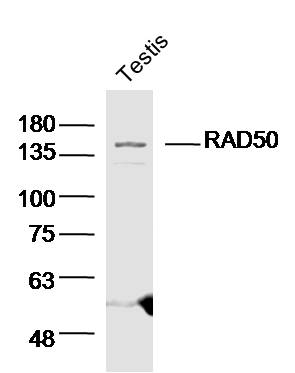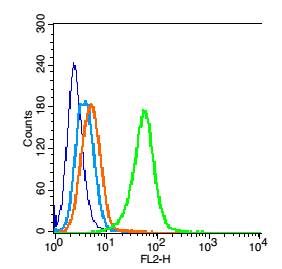
Rabbit Anti-RAD50 antibody
DNA repair protein RAD50; hRad50; hsRAD50; Mrell; NBSLD; Rad 50; RAD50 2; rad50; RAD50 homolog (S cerevisiae); RAD50 homolog; RAD50 PEN; RAD50_HUMAN; Rad50l; Truncated RAD50 protein.
View History [Clear]
Details
Product Name RAD50 Chinese Name DNA修复蛋白Rad50抗体 Alias DNA repair protein RAD50; hRad50; hsRAD50; Mrell; NBSLD; Rad 50; RAD50 2; rad50; RAD50 homolog (S cerevisiae); RAD50 homolog; RAD50 PEN; RAD50_HUMAN; Rad50l; Truncated RAD50 protein. literatures Research Area Chromatin and nuclear signals Epigenetics Immunogen Species Rabbit Clonality Polyclonal React Species Human, Mouse, (predicted: Rat, Cow, Horse, Rabbit, Sheep, ) Applications WB=1:500-2000 ELISA=1:5000-10000 IHC-P=1:100-500 IHC-F=1:100-500 Flow-Cyt=0.2μg/Test ICC=1:100-500 IF=1:100-500 (Paraffin sections need antigen repair)
not yet tested in other applications.
optimal dilutions/concentrations should be determined by the end user.Theoretical molecular weight 154kDa Cellular localization The nucleus Form Liquid Concentration 1mg/ml immunogen KLH conjugated synthetic peptide derived from human RAD50: 817-872/1312 Lsotype IgG Purification affinity purified by Protein A Buffer Solution 0.01M TBS(pH7.4) with 1% BSA, 0.03% Proclin300 and 50% Glycerol. Storage Shipped at 4℃. Store at -20 °C for one year. Avoid repeated freeze/thaw cycles. Attention This product as supplied is intended for research use only, not for use in human, therapeutic or diagnostic applications. PubMed PubMed Product Detail The protein encoded by this gene is highly similar to Saccharomyces cerevisiae Rad50, a protein involved in DNA double-strand break repair. This protein forms a complex with MRE11 and NBS1. The protein complex binds to DNA and displays numerous enzymatic activities that are required for nonhomologous joining of DNA ends. This protein, cooperating with its partners, is important for DNA double-strand break repair, cell cycle checkpoint activation, telomere maintenance, and meiotic recombination. Knockout studies of the mouse homolog suggest this gene is essential for cell growth and viability. Mutations in this gene are the cause of Nijmegen breakage syndrome-like disorder.
Function:
Component of the MRN complex, which plays a central role in double-strand break (DSB) repair, DNA recombination, maintenance of telomere integrity and meiosis. The complex possesses single-strand endonuclease activity and double-strand-specific 3'-5' exonuclease activity, which are provided by MRE11A. RAD50 may be required to bind DNA ends and hold them in close proximity. This could facilitate searches for short or long regions of sequence homology in the recombining DNA templates, and may also stimulate the activity of DNA ligases and/or restrict the nuclease activity of MRE11A to prevent nucleolytic degradation past a given point. The complex may also be required for DNA damage signaling via activation of the ATM kinase. In telomeres the MRN complex may modulate t-loop formation.
Subunit:
Component of the MRN complex composed of two heterodimers RAD50/MRE11A associated with a single NBN. Component of the BASC complex, at least composed of BRCA1, MSH2, MSH6, MLH1, ATM, BLM, RAD50, MRE11A and NBN. Found in a complex with TERF2. Interacts with RINT1. Interacts with BRCA1 via its N-terminal domain. Interacts with DCLRE1C/Artemis.
Subcellular Location:
Nucleus. Chromosome telomere. Localizes to discrete nuclear foci after treatment with genotoxic agents.
Tissue Specificity:
Expressed at very low level in most tissues, except in testis where it is expressed at higher level. Expressed in fibroblasts.
Post-translational modifications:
Phosphorylated upon DNA damage, probably by ATM or ATR
DISEASE:
Defects in RAD50 are the cause of Nijmegen breakage syndrome-like disorder (NBSLD) [MIM:613078]; also called NBS-like disorder or RAD50 deficiency. NBSLD is a disorder similar to Nijmegen breakage syndrome and characterized by chromosomal instability, radiation sensitivity, microcephaly, growth retardation, short stature and bird-like face. Immunodeficiency is absent.
Similarity:
Belongs to the SMC family. RAD50 subfamily.
Contains 1 zinc-hook domain.
SWISS:
Q92878
Gene ID:
10111
Database links:Entrez Gene: 10111 Human
Entrez Gene: 19360 Mouse
Omim: 604040 Human
SwissProt: Q92878 Human
SwissProt: P70388 Mouse
Unigene: 633509 Human
Unigene: 4888 Mouse
Unigene: 51136 Rat
Product Picture
Primary: Anti-RAD50(SL11230R)at 1/300 dilution
Secondary: IRDye800CW Goat Anti-Rabbit IgG at 1/20000 dilution
Predicted band size: 154kD
Observed band size: 154kD
Blank control: 293T cells(fixed with 2% paraformaldehyde (10 min) , then permeabilized with 90% ice-cold methanol for 30 min on ice).
Primary Antibody:Rabbit Anti-RAD50 antibody(SL11230R), Dilution: 0.2μg in 100 μL 1X PBS containing 0.5% BSA;
Isotype Control Antibody: Rabbit IgG(orange) ,used under the same conditions );
Secondary Antibody: Goat anti-rabbit IgG-PE(white blue), Dilution: 1:200 in 1 X PBS containing 0.5% BSA.
References (0)
No References
Bought notes(bought amounts latest0)
No one bought this product
User Comment(Total0User Comment Num)
- No comment




 +86 571 56623320
+86 571 56623320
 +86 18668110335
+86 18668110335

